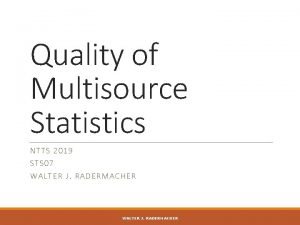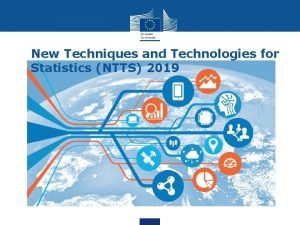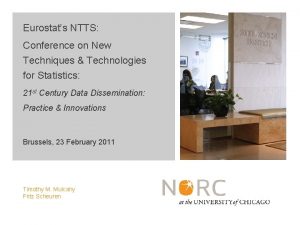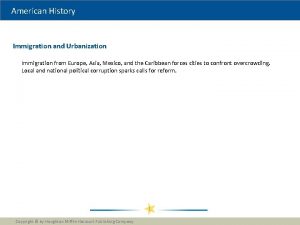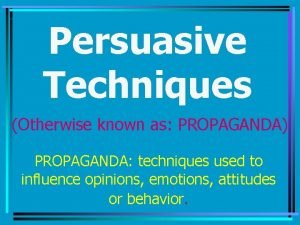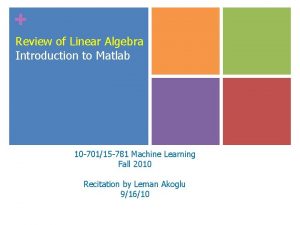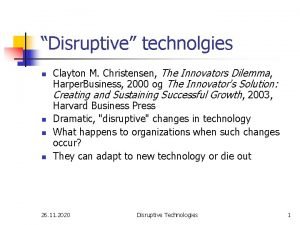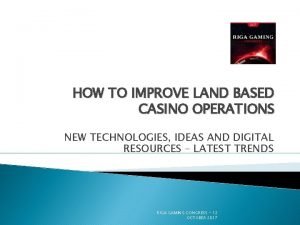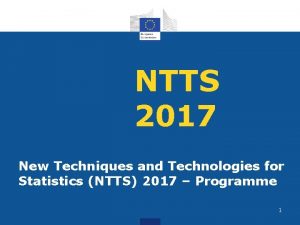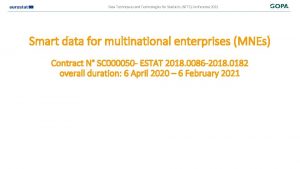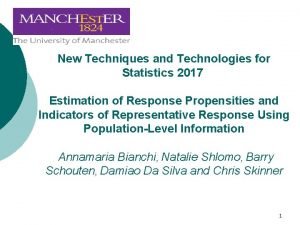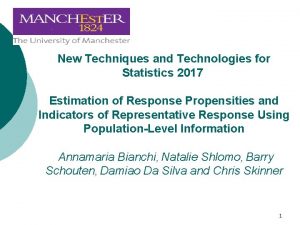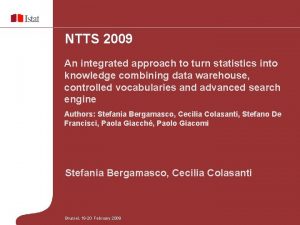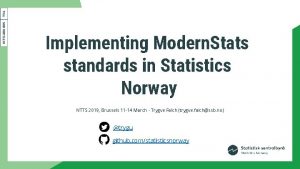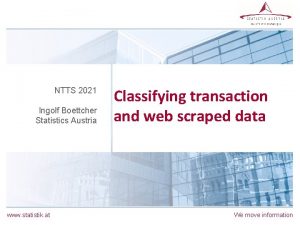New Techniques and Technologies for Statistics NTTS 2017
















- Slides: 16

New Techniques and Technologies for Statistics NTTS 2017 – 14 -16 March 2017 – Brussels (BE) Session 6 A - Mobile phone data for mobility statistics: using mobile phone data for statistics on tourism and transport Better quality of mobile phone data based statistics through the use of signalling information – the case of tourism statistics Christophe Demunter (European Commission / Eurostat) Gerdy Seynaeve (Proximus)

outline 1 - the project 2 - data sources 3 - some results 4 - wrapping up 2

1 - the project Prehistory § Feasibility study on the use of mobile positioning data for tourism statistics (Eurostat) – 2012 -2014 § Creation of Task Force on Big Data - 2013 3

1 - the project Research team § Partnership between statistical offices and mobile network operator (MNO) ð Eurostat ð Proximus ð Statistics Belgium 4

1 - the project Objectives § Explore partnerships and business models for cooperation between MNOs and NSIs ð Access ð Exploring, testing, pilots ð Regular data processing and production ð Continuity, viability of cooperation § Cooperate on concrete, output-oriented projects ð Population statistics (present/resident population) ð Tourism statistics ð … 5

1 - the project NTTS 2017 papers Land use classification based on present population daily profiles from a big data source [5 A-001] ð Session 5 A: Using mobile phone data for official statistics on land use, urban areas and dwellings Better quality of mobile phone data based statistics through the use of signalling information – the case of tourism statistics [6 A-001] ð Session 6 A - Mobile phone data for mobility statistics: using mobile phone data for statistics on tourism and transport Official statistics and mobile network operators: a business model for partnerships [8 C-003] ð Session 8 C: New organisation and collaboration approaches to foster innovation in official statistics… 6

2 – data sources Source 1: mobile phone data § Data from one operator in Belgium: PROXIMUS § Signalling data (no longer on call detail records) § 10 x more observations than CDR [on the home network] § superior for monitoring day-to-day mobility § position of devices detected every 3 hrs (if not switched off) g minimum every hour for devices with data 'on' g but through active usage for calls, messages, data, the detection frequency is much higher: o 70% of devices detected within one hour, o 35% within 15 minutes (daytime) § Better temporal (and geographical) granularity 7

2 – data sources Source 2: official tourism statistics § Survey based data on trips made by residents of Belgium ð In line with EU Regulation 692/2011 concerning European statistics on tourism ð Quarterly interviews, annual sample ± 10000 trips (domestic + outbound trips with overnight stays) ð Relatively low response rate (unit non-response ≈ 85%) 8

2 – data sources Known weaknesses Mobile phone data Official tourism statistics Selectivity bias Non-response, non-contact, . . . • Extrapolation (inverse of market share) Recall bias, memory effect • Socio-demographic composition of subscribers Respondent burden, fatigue • Intensity of use Entirely algorithm based (choice of parameters? ) Entirely respondent based ('subjective opinion') Continuity Timeliness Privacy, public opinion 9

2 – data sources Scope (first stage of the project) § Focus on outbound trips with at least 1 overnight stay ð Mobile phone data: trips made April – Sept 2016 ð Official tourism statistics: trips made April – Sept 2015 § Definition of an outbound trip ð From leaving the home network to returning ð Number of nights: number of hours divided by 24 ð Overnight stay: minimum 10 hours and return after 4 am § Usual environment (= key concept in tourism statistics) ð Duration (min. 10 hrs + incl. 4 am), border crossing (outbound) ð Filtering of frequent trips to the same destination during a given reference period (250 days) threshold = 5 (arbitrary) 10

3 – some results Ranking of tourism destinations Ranking of EU-28 countries as destination for Belgian outbound trips (MNO data) 11

3 – some results Outbound trips by duration: comparison Comparison of the distribution of outbound trips to EU-28 and to Italy, by duration of the trips 12

3 – some results Volume of trips and nights: comparison Comparison of estimated number of outbound trips, by destination

3 – some results Volume of trips and nights: comparison (2) § Observations ð Big difference between MNO and NSI estimates ð Systematic nature § Understanding (and solving…) the deviations ð Difference in scope (e. g. age limit) & reference year ð Selectivity bias and impact on extrapolations ð Intermediate results, model & algorithm optimisation ongoing (e. g. parameter setting for 'usual environment') ð Dealing with recall bias in survey based data (15 -20%) ð Impact of non-response in surveys (structural bias? ) § The project continues … 14

4 – wrapping up First lessons learnt § Positive & fruitful experience with the partnership ð Joining forces (statisticians, data holders, data scientists) ð Search for a win-win § Promising results, but lots of homework ð The data makes sense : mobile phone data clearly captures tourism concepts/definitions ð Currently: satisfactory for trends, not for estimating volumes ð How to make the series/sources converge to the unknown true values? ð Extension to domestic tourism, to same-day visits § Further research to be encouraged (other countries? ) 15

Thanks for your attention christophe. demunter@ec. europa. eu gerdy. seynaeve@proximus. com 16
 Ntts cost
Ntts cost Ntts conference 2021
Ntts conference 2021 Ntts conference
Ntts conference Immigration and urbanization new technologies lesson 4
Immigration and urbanization new technologies lesson 4 Introduction to statistics what is statistics
Introduction to statistics what is statistics Name-calling examples
Name-calling examples Linearly independen
Linearly independen New disruptive technologies 2021
New disruptive technologies 2021 New disruptive technologies
New disruptive technologies New casino october 2017
New casino october 2017 Fonction technique scooter
Fonction technique scooter Kontinuitetshantering i praktiken
Kontinuitetshantering i praktiken Typiska novell drag
Typiska novell drag Nationell inriktning för artificiell intelligens
Nationell inriktning för artificiell intelligens Returpilarna
Returpilarna Varför kallas perioden 1918-1939 för mellankrigstiden?
Varför kallas perioden 1918-1939 för mellankrigstiden? En lathund för arbete med kontinuitetshantering
En lathund för arbete med kontinuitetshantering
